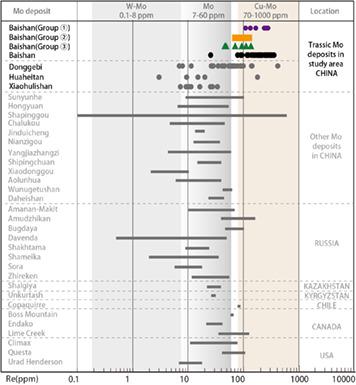新疆东天山白山钼矿床富Re辉钼矿成因
IF 0.8
4区 地球科学
Q3 GEOLOGY
引用次数: 2
摘要
白山钼矿床位于中国东天山-北山构造带中段。矿床赋存于早石炭世甘墩组富含黑云母的角岩中,与矿体下方未暴露的花岗闪长斑岩有遗传关系。辉钼矿从早期到晚期分为三种不同类型:辉钼矿-铁-铜-硫化物-钾长石-石英脉(组1);辉钼矿-铁-铜-硫化物-石英脉(组2);第1组辉钼矿颗粒中铼含量为108 ~ 277 ppm,第2组为69 ~ 121 ppm,第3组为46 ~ 135 ppm。X射线衍射结果显示,白山钼矿Re含量由早到晚、由中心到外围呈递减趋势,且组1和组2为2H1多型,组3为2H1 + 3R2H1多型。富Re辉钼矿可能是由下地壳高氧化、富H2O和挥发物的埃达质侵入体分离出来的氧化岩浆液形成的。本文章由计算机程序翻译,如有差异,请以英文原文为准。

Genesis of Re‐rich Molybdenite in the Baishan Mo deposit, Eastern Tianshan, Xinjiang, Northwest China
The Baishan molybdenum deposit is located in the central part of the Eastern Tianshan‐Beishan tectonic belt, NW China. The deposit is hosted in early Carboniferous Gandun Formation biotite‐rich hornfels and is genetically related to unexposed granodiorite porphyry beneath the orebodies. The molybdenite occurs in three different types from early to late stage: Molybdenite ‐ Fe‐Cu‐sulfides ‐ K‐feldspar ‐ quartz veins (Group 1); Molybdenite ‐ Fe‐Cu‐sulfides ‐ quartz veins (Group 2); and disseminated molybdenite in the wall rock (Group 3). Rhenium concentrations in the molybdenite grains range from 108 to 277 ppm in Group 1, 69–121 ppm in Group 2 and 46–135 ppm in Group 3. The Re concentrations of molybdenite in the Baishan Mo deposit decrease from early to late and from the center to periphery, and molybdenite types vary from the 2H1 poly‐type in Groups 1 and 2 to the 2H1 + 3R2H1 poly‐type in Group 3, based on X‐ray diffraction results. The Re‐enriched molybdenite probably formed from an oxidized magmatic fluid that separated from a highly oxidized and H2O‐ and volatile‐enriched adakitic intrusion generated in the lower crust.
求助全文
通过发布文献求助,成功后即可免费获取论文全文。
去求助
来源期刊

Resource Geology
地学-地质学
CiteScore
2.30
自引率
14.30%
发文量
18
审稿时长
12 months
期刊介绍:
Resource Geology is an international journal focusing on economic geology, geochemistry and environmental geology. Its purpose is to contribute to the promotion of earth sciences related to metallic and non-metallic mineral deposits mainly in Asia, Oceania and the Circum-Pacific region, although other parts of the world are also considered.
Launched in 1998 by the Society for Resource Geology, the journal is published quarterly in English, making it more accessible to the international geological community. The journal publishes high quality papers of interest to those engaged in research and exploration of mineral deposits.
 求助内容:
求助内容: 应助结果提醒方式:
应助结果提醒方式:


